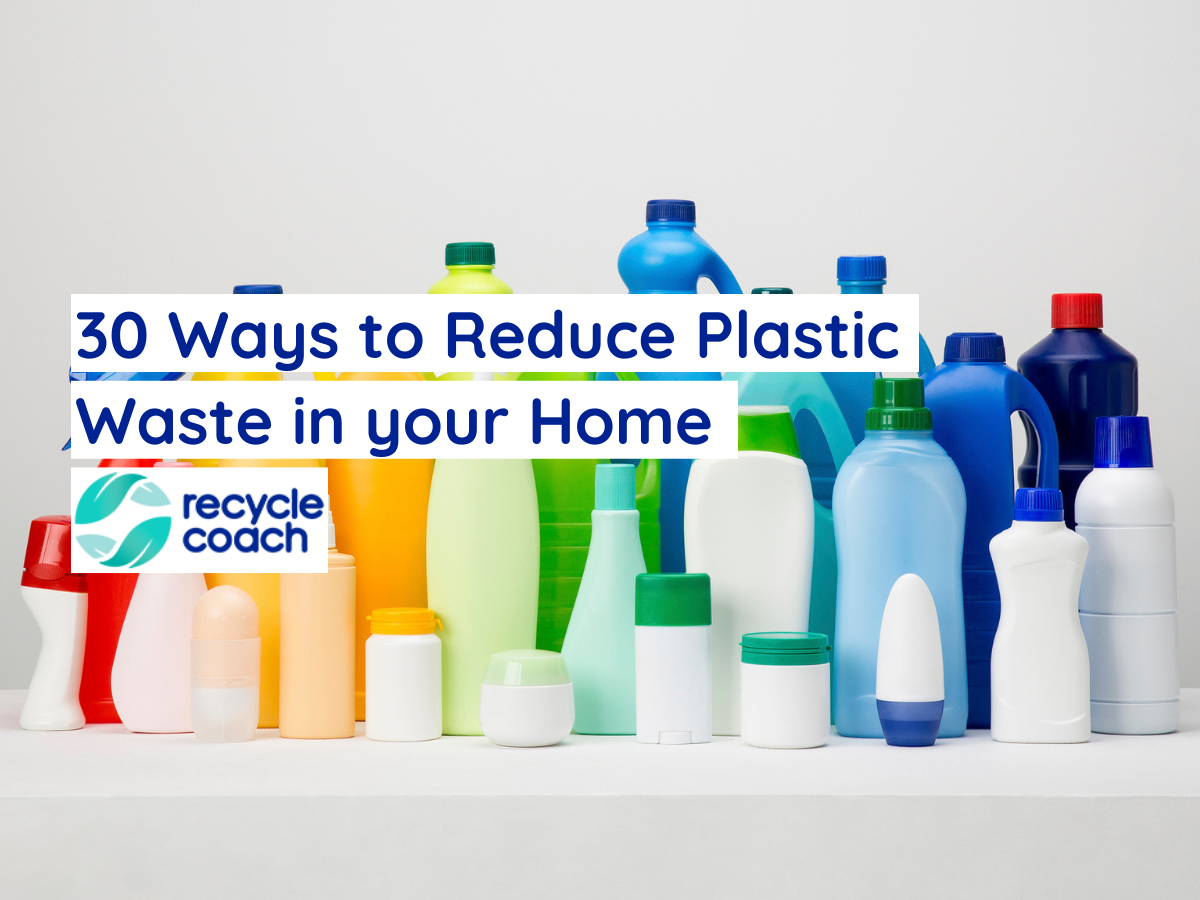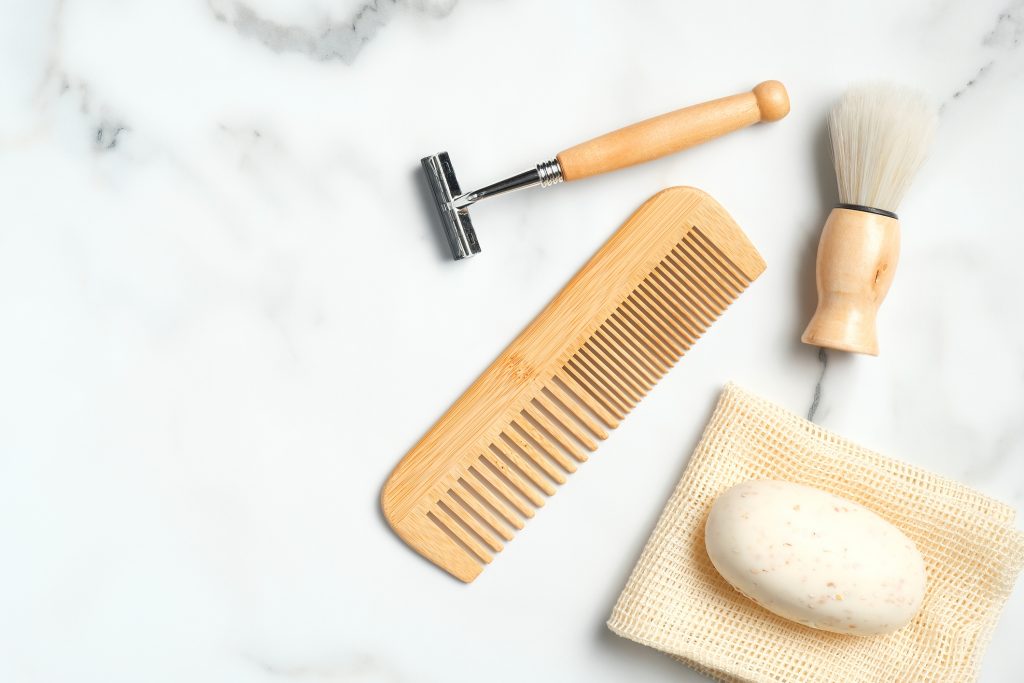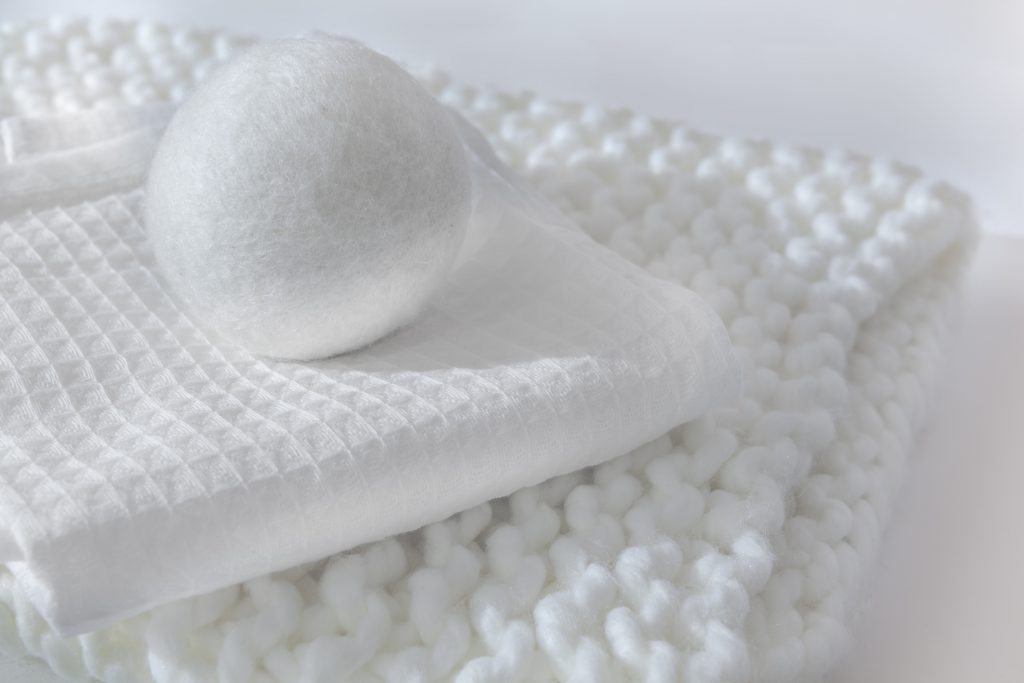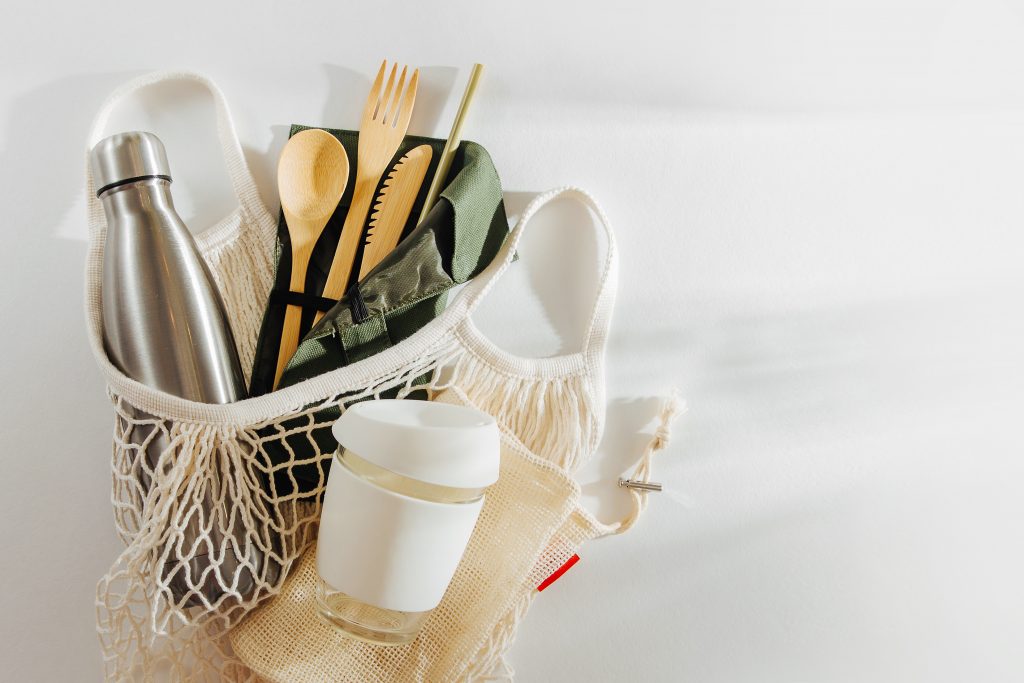30 Ways to Reduce Plastic Waste in your Home

It feels impossible to go plastic free nowadays, but even if we can’t solve the problem overnight, there are plenty of ways to help reduce plastic waste in your home to start making a positive impact on our environment.
What happens to all that plastic after we’re done with it? We hope it gets recycled, but not all of it does. Only about 9% of all plastic produced gets recycled, which means the rest is sent to landfills or ends up as litter –all too often ending up in our oceans.
While it would be wonderful if we could snap our fingers and fix the problem, it’s not that simple. What we can control and change in our own households is a first step that can get the ball rolling for a positive change in how plastic is disposed of.
Sweeping changes in your household can feel overwhelming and sometimes impossible, so it’s always good to take it one step at a time. Switch one thing, then when you feel comfortable, switch another. Make your way through the list as it works for your lifestyle and budget.
Making a small change to reduce plastic waste can make a big difference over time!
Reduce Your Personal Care Plastic Waste

1. Switch to Shampoo Bars
Plastic shampoo bottles are often overlooked as a recyclable item. In fact only 1 in 5 people recycle any bathroom items on a regular basis. That means we are creating a lot of unnecessary waste because we are more focused on recycling items in the kitchen.
Plastic shampoo bottles are almost always recyclable, but make sure they are empty and clean, not lined with shampoo residue which can cause contamination.
Instead of falling into the trap of forgetting to recycle that bottle, the better solution is to take your plastic waste out of the equation. Shampoo bars are gaining a lot of popularity, so there are a ton of great options out there. They’re essentially a bar of soap for your hair and have a great lather without using as much product.
2. Go with Metal Razors
This is an easy fix with an old-school solution. Instead of adding to plastic waste, you can stop buying reusable and buy a metal razor that will possibly last you a lifetime. Yes, it’s expensive to buy a durable, old-school metal razor initially, but think of how much you are spending on plastic disposable razors that you buy repeatedly.
3. Rethink your Deodorant
Deodorant containers are a tricky item for recycling. They look like many other recyclable plastic items, but they aren’t recyclable at all. Most areas won’t accept them because they often contain more than one type of plastic. Plastics need to be recycled with the same type of plastic, so mixed plastic items that can’t be separated on the conveyor belt, get sent to the landfill.
Make sure the actual deodorant is plastic-free as well, and make a change by buying deodorant that comes in biodegradable, compostable, or recyclable packaging. Many of these options consist of cardboard sticks, glass jars, or even just deodorant bars.
4. Choose Wooden Combs
This is such an easy way to reduce plastic waste since you can usually find a natural hairbrush at most locations that sell them. Combs may be a little harder to find, but they are out there at most beauty stores. In addition to doing something good for the environment, wooden combs are more beneficial for your hair’s health. Plus, they reduce static while brushing!
5. Change your Menstrual Routine
Sanitary pads are often either made of plastic or lined with plastic. On top of that, they come in individually wrapped plastic packaging. The US alone discards about 12 billion pads per year. That’s a lot of plastic! In recent years, there have been many products emerging that can help reduce plastic waste for your menstrual routine such as period underwear, reusable fabric pads, and menstrual cups.

6. Swap Out your Plastic Toothbrush
It is estimated that about 1 billion toothbrushes are thrown away each year in the US alone. That is a lot of plastic. It is easy enough reduce this plastic waste by switching over to a bamboo toothbrush. Untreated bamboo is compostable, but even if you don’t compost or have an organics program that accepts bamboo, the time it takes to decompose in a landfill is significantly lower.
One thing to watch for when choosing a bamboo toothbrush is the bristles. Some will still use plastic and even offer replacement bristles, so you don’t have to replace the entire brush. Others will use natural fibers so the whole brush is disposed of once you’re done. There are many options out there, you just need to choose what works best for your lifestyle.
7. Switch to Silk Dental Floss
This is a plastic item that often gets overlooked. Due to its small size, it’s easy to disregard it as a plastic waste problem, yet it still counts as plastic waste. This is fixable by switching over to silk dental floss. Most of these alternatives also provide plastic-free packaging, which is a double plastic waste reduction!
8. Use Dry Toothpaste
Plastic tubes of toothpaste are not recyclable and even if they were, it would be inconvenient to make sure they are empty and clean. You can reduce this plastic waste by switching to toothpaste tablets or powder. It’s the same clean feeling on your teeth, but the companies making this type of product are making it with a more eco-friendly and often healthier, all-natural materials.
9. Chew your Mouthwash
You can double down on reducing your plastic waste for your oral hygiene and use chewable mouthwash. Read the label on those because you can’t swallow most of them. These products can help get rid of the plastic packaging waste in your home.
Reduce Plastics in your Cleaning Products

10. Use Natural Sponges
We need to wash our dishes, but those go-to sponges are made from plastic. After you use them for a week or so, they get yucky looking and smelly, so of course you need to throw them out. They are not recyclable, so to the landfill they go. If every household is throwing away their plastic kitchen sponge every week, think of how much plastic waste that creates from one item!
The best solution is to change what you use for a sponge to reduce your plastic waste. If you want something like a classic kitchen sponge with a scouring pad on one side, walnut or coconut sponges are great options. But there are plenty of washable or biodegradable replacements, like natural sponges, regular dishrags, or Swedish dishtowels.
11. Refill with Soap Tablets
This is a plastic waste reducing switch that is so simple and convenient to make. Instead of buying new soap dispensers, or even soap refill bottles, there are now dissolvable tablets that you can drop in water to fill you soap dispenser. Think of how much easier it would be to fill your dispenser up with water, dropping in a tablet, then shaking!
Some companies make tablets for your cleaning supplies too! Another easy way to clean around the house would be to make your own cleaning solutions from all natural ingredients.
12. Switch to Laundry Strips
Raise your hand if you hate lugging around heavy laundry detergent containers! There’s nothing lighter than laundry strips. They are already portioned out for you, and you just throw them in to replace the detergent. Then instead of a big plastic container that you don’t want to bother rinsing out (because it needs to be empty and clean), you have a small recyclable cardboard envelope.
13. Use Dryer Balls
You can get wool dryer balls everywhere now. Not only do they dry your clothes faster so you can use less energy on your drying time, they also replace your fabric softener. Just another big clunky plastic container you don’t need to carry to the laundry!
They last a long time, so you rarely must replace them, especially compared to the many plastic bottles or plastic dryer sheets you would normally be using. And if you want something scented, you can drop some essential oils on the ball which will freshen up the load nicely.
14. Get Detergent in a Box
Dishwashing has become an extremely plastic heavy market. Not only are most options coming out of a big plastic bottle – those dissolvable pods are made with plastic too. There are many ways plastic is making its way into our water, but this one seems obvious, and we do it on purpose.
There are so many dangers to our ecosystem when microplastics end up in our water, and subsequently the food chain. Detergent pods (including both dishwasher and laundry pods) are not an eco-friendly solution just because you aren’t left with the packaging to deal with. Switching to a cardboard container makes for a much easier recyclable packaging option that reduces plastic waste.
15. Replace Disposable Dusters
Swiffer was a game changing cleaning invention, I’ll admit. When it came on the market, it picked up so much more dust and dirt than regular sweeping. But now, there are plenty of microfiber cloths that do the same type of cleaning and are washable instead of disposable.
Buying a few of these is less expensive than buying disposable dusting cloths and you won’t be throwing those disposable polyester cleaners away. Even if you don’t switch to microfiber cloths and you use a regular old rag on your sweeper, you will reduce a bunch of polyester plastic waste in your home.
16. Avoid Wet Wipes
Wet wipes are a sneaky plastic. They look like they are maybe just like a paper towel or cloth even, but they are made from a mix of plastics. On top of that, so many of them say they are flushable, but there is no plumber in the world that will say it is a good idea to flush them. They cause a huge clogging problem when flushed. In addition, flushing these plastic items adds plastics to our groundwater.
Switching from wet wipes and disinfectant wipes around the house to towels, rags, and cleaning solution is a tiny adjustment, but a doable one. The harder switch would be if you have kids, and you use wet wipes while changing. There are many washable wipes on the market for diapers. And if you need them wet, you could buy or make some baby butt spray for clean up!
Cut Down your Dining Plastic Waste

17. DIY your Water Filtration
This plastic waste reducer is a little bit DIY, so may not be for everyone. You can replace your plastic Britta and disposable filters with either a Bichotan charcoal stick, or by using a Terracotta pot system.
Directions for these methods are here.
If this one is a bit too much to handle, you could buy a filtration system that uses less plastic, but they can be quite expensive. Companies like ZeroWater, Berkey Filters, and Soma are trying to lessen the plastic waste with their water filtration systems.
18. Invest in a Reusable Water Bottle
Disposable plastic water bottles have become the norm for the last 30 years or so. It’s hard to remember that we used to drink out of glasses. Now, more than one million plastic bottles are used per day worldwide! And only a small fraction of them get recycled.
The easiest solution to reduce plastic waste in your home and on the go is to carry a reusable water bottle with you. Plastic bottles are one of the leading contributors of microplastics in our water supply. If you’re interested in stepping up your game in the fight against plastic in our water, you might even think about participating in a coastal cleanup program.
19. Bring your Travel Mug
Similarly to the reusable water bottle solution above, a reusable travel mug for your coffee would solve a huge problem with disposable plastic waste from coffee shops. Disposable coffee cups pose a big problem because they look like they are paper, but they are also lined with plastic.
This means most locations won’t accept them in their recycling program. Plus, there are the plastic lids to think of too. Travel mugs are a quick and easy solution.
20. Avoid Straws
This one seems obvious as we see the straw bans sweeping the country. The US has been disposing of half a billion straws a day for quite some time now. There are many plastic straw alternatives out there now and many fast food establishments have switched to paper straws as a disposable alternative.
21. Bring Reusable Containers and Cutlery to Work
Although Tupperware is plastic, it is reused over and over, so the plastic waste from these is significantly reduced when reused. It’s even better when you can reuse containers that other food came in—for example, put your lunch in the old butter container and your salad in the old sour cream container.
Plastic cutlery is not usually accepted for recycling, so a great idea is to keep a fork, spoon, and knife in your desk drawer to reuse every day. That can help you reduce a lot of plastic waste at work.
22. Ask for No Extras with Take-Out
Take out can come with a ton of packaging. If you get black plastic containers, those aren’t recyclable, so you should reuse them or see if there’s a food pantry that may take them as a donation. Even if you get take out in cardboard containers, they run the risk of having grease and food absorbed into them which is a recycling contaminant.
There’s one simple way to lessen the takeout waste issue. Ask for no condiment packets and no plastic cutlery. That will mean less plastic waste from your meal.
23. Use Beeswax Wraps
Plastic wrap is one of those plastics that you might not even think about because it is so ingrained in how we store our food. A great plastic free alternative is to use beeswax wraps to cover bowls or store vegetables in the fridge. They come in different sizes and can last around a year with proper care. They are also usually compostable and have super cute designs!
24. Choose a Sustainable Sandwich Bag
You can wash and reuse plastic sandwich bags the same way as Tupperware, but most people just throw them away after one use. If you’re looking for a snack pouch, there are great washable cloth snack bags that can cut out your bag waste. On the other hand, if you’re looking to keep something fresh, silicone bags are a great sustainable alternative. There are even freezer bag options out there.
25. Buy Wine with Natural Corks
Cork is an amazing renewable natural resource. There is no need to cut down trees to harvest it. While it is not generally accepted as a recyclable item in curbside programs, there are plenty of cork recycling initiates, such as ReCork, that have come up with amazing products with recycled cork.
Really there’s no need for wine bottles to use plastic corks to add to plastic waste. If you’re not sure which wines use real or plastic cork, there’s an app for that. Otherwise, you can always choose a wine with a screw off top instead.
Buy More Sustainable Products

26. Bring your Own Bags
Plastic shopping bags cause a ton of problems in the world of recycling. They can be brought to drop-off locations for recycling at most grocery stores, but not in your curbside pick-up. Now there are also bag bans popping up all over the place. The best thing to do would be to get used to this inevitable change now, and carry reusable bags to the grocery store to reduce plastic waste.
27. Seek Out Plastic-Free Packaging
It’s hard to be a plastic-free consumer since it’s so common in our products now. But as more companies embrace how detrimental plastic packaging is to our environment, and as natural material options have become a more affordable option for businesses, we are starting to see a shift back to plastic-free materials.
I think as the next few years pass and more innovations in packaging come to light, we will see a positive change of companies moving to plastic-free packaging. If we as consumers start giving our money to companies that avoid plastic, other companies will continue to follow.
28. Wear Natural Materials
Textile waste is a major issue as clothing is less durable and more disposable. Worldwide, approximately 92 million tons of textile waste is generated per year. Of course, not all of that is plastic, but I bet if you look at the label on your clothing, very few items will be made of 100% natural materials. Not to mention the thread and actual labels often have plastic in them too.
When buying clothing, try to buy natural materials whenever possible to reduce the amount of polyester plastic ends up in a landfill down the line.
29. Switch to Cloth Diapers
Disposable diapers currently make up 30% of non-biodegradable waste in landfills. Switching from disposable to cloth diapers would help make a huge impact in reducing plastic waste in our landfills.
Cloth diapers are a bit overwhelming to new parents, but once you get the hang of it, it will be no problem at all. A bonus is that the upfront cost of cloth diapers will still be much lower than the overall cost you’ll spend for disposables. If you don’t want to deal with cleaning them, there are now many pick up services that will wash them for you.
30. Gift Natural Baby Toys
Wooden and natural baby toys are a great way to avoid buying plastic. Babies put all toys in their mouths, so a wooden toy instead of a plastic one is a healthier option. The next baby shower you buy for, buy natural.
Try Your Best
Phew, that’s a lot of plastic waste to think about! It’s best to take things one at a time to not become overwhelmed. This list will help you recognize where you can have the most eco-impact on your next shopping trip. Keep this list in mind when making choices for your future purchases and you can reduce the plastic waste in your home significantly.
2 Comments
Comments are closed.
River
November 10, 2021 at 10:00 am“seek out plastic free packaging” is a BIG one! I try to do this as much as I can but it’s so hard! Everything comes in plastic, it feels like. We switched to glass Tupperware and we use reusable bags and water bottles. I also get glass cooler bottles from bear springs instead of plastic ones. They’re amazing, and one of the plastic swaps that I feel most happy about!
Valorie Hilbmann
July 20, 2022 at 3:05 pmGreat article so thank you so much. I try really hard to live a less plasticky life, but it is really hard. My husband is a good man, but only half supports my efforts, going more for convenience instead. I’m glad to be reminded that others out there understand the importance and are willing to make the effort. Thank you.